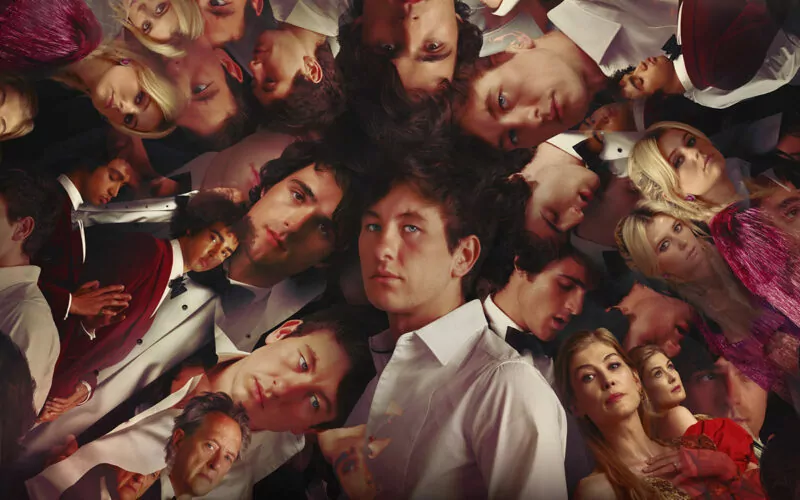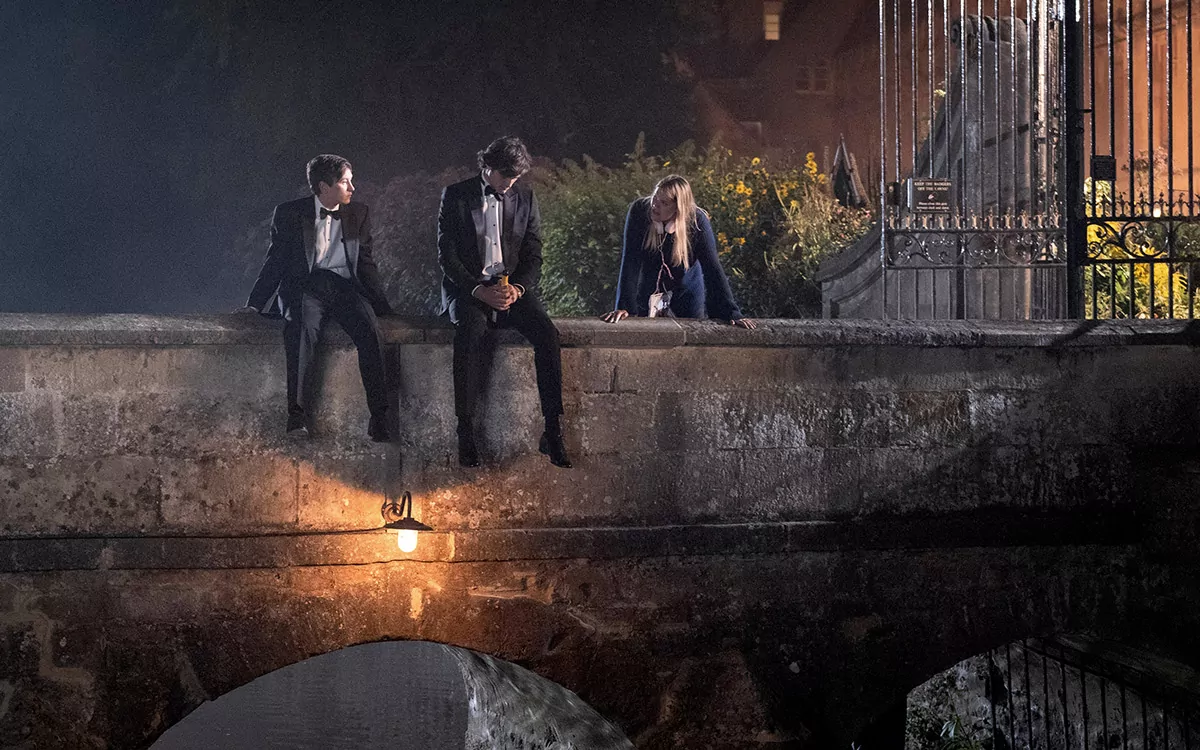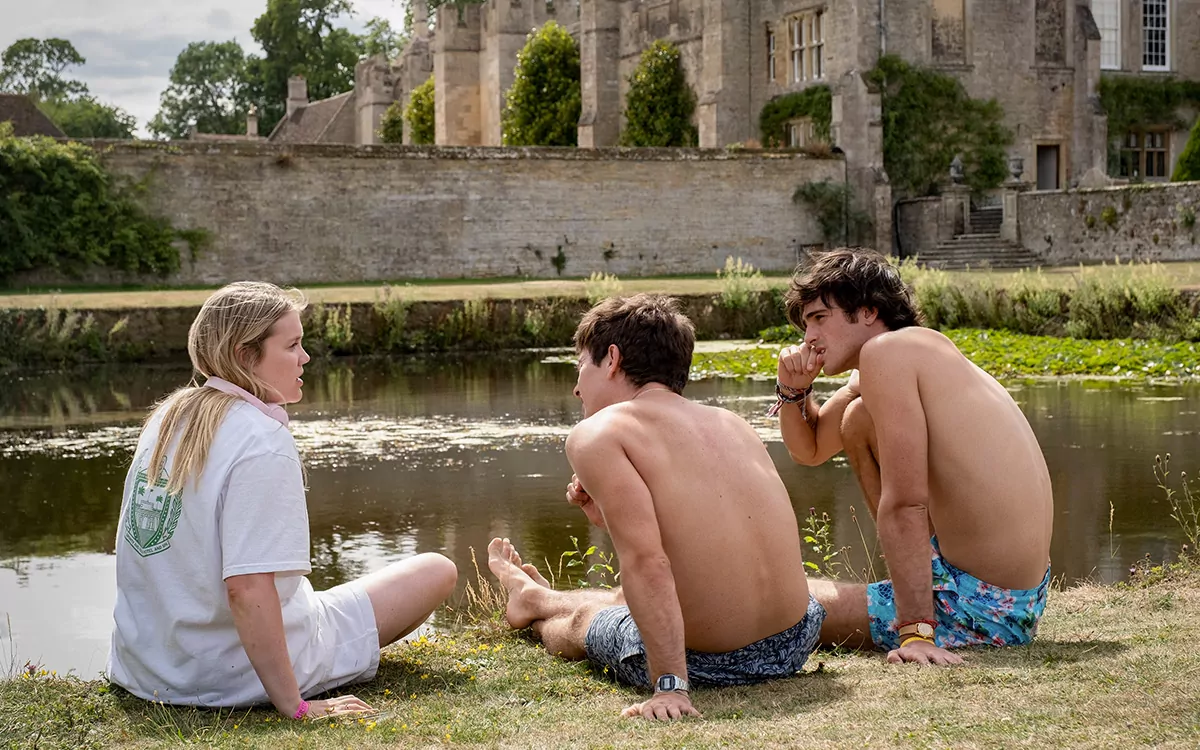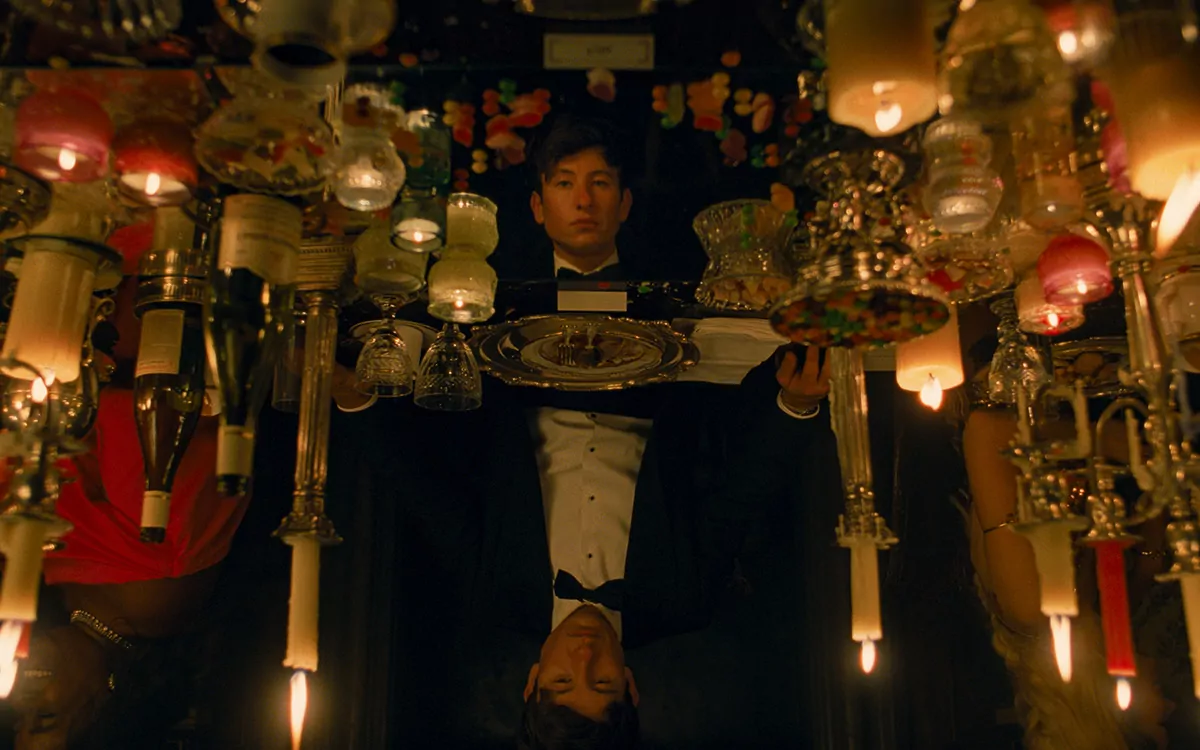‘Saltburn’: Unmasking the Glamour and Grit Behind the Scenes with the Film’s Cinematographer, Production Designer, Composer, and More

In the world of filmmaking, every element – from location and set design to costume and music – plays a pivotal role in creating a compelling narrative. And that holds especially true with Emerald Fennell’s Saltburn.
I had the chance to hear the film’s creative team talk about their approach to Saltburn, from how production designer Suzie Davies breathed life into an ancient estate, how composer Anthony Willis crafted a nostalgic, haunting score, and how costumer Sophie Canale captured the fashion of the time. Additionally, cinematographer Linus Sandgren, ASC, FSF, explained why the film went with a 1.33 aspect ratio, and hair and makeup designer Siân Miller explained what went into creating the characters’ looks.
From the grandeur of the sets to the subtle details in costumes and makeup, discover the meticulous work that went into creating one of the year’s best films, Saltburn.

Saltburn has a lot of texture that accentuates the film’s themes and is shot on a 1.33 aspect ratio. Can you tell us a little bit about the intentions behind those decisions and how you ultimately found the look for the film?
Linus Sandgren: I feel like every time [I start on a film], I want to start with a blank page and not have anything in mind until I talk to the director.
This film has a very unique script and a director with a unique mind. In our discussions, she felt that it had to be expressive and be about these themes of desire that we have in the film.
We talked about German expressionism for the sort of vampire theme without being specific, but just in terms of guiding us in some ideas. And I think we all, all of us here, worked with mood boards of different kinds that were connected, and it was connected through Baroque art like Caravaggio, Gentileschi about stills from Nosferatu perhaps, or something like in the core of the theme. But there are obviously more themes than that. For example, summer, the hot summer days would be the complete opposite of that.
That had to do with what emotions we wanted to convey, but in an expressive way to sort of help illustrate whatever goes on in the film emotionally in a visual language so that if, for whatever reason, no one sees it with sound, they could still understand it.
For the aspect ratio, being expressive, I feel like the aspect ratio is a great tool to illustrate an expressive image. It could be in 2.4, I guess. But not as much in maybe a 1.78 or 1.85. However, 1.33 is also very expressive. It’s also how they shot the German expressive, expressionistic films in 1.33. It’s exactly like we did. We shot it on film in 1.33, like the silent movies. To me, it’s easier to compose in such a way as you did in most paintings.
You use the golden ratio. And I feel like, in that composition, it reminds me more of paintings and the way we could compose things. There was also a part of it that Emerald felt like it should feel like we’re looking into this looking glass, sort of into this doll house.
This doll house, being the manor, also had very square, tall rooms with high ceilings, which wouldn’t be possible to see in a more widescreen format. So, that was part of it, too. The combination of things that made us feel like we wanted to do it. And once we started composing in that format, we all fell in love with it.

Speaking of the house as a dollhouse, Suzie, what can you tell us about the estate at Saltburn? How did you come across it? And what were some of your earlier entry points into this place and dressing it for?
Suzie Davies: So I’d love to sit here, telling you that it was all a build on the back lot of Pinewood somewhere. But actually, we were very fortunate to find this house. On reading the script, it was clear that we didn’t want to film in any of the houses we know so well from English films and TV.
So word was put out, and word came back. And we managed to get into this amazing, amazing property up in the middle of England. And it’s quite extraordinary. I definitely had an Oliver moment driving up for the first time and seeing the fantastic layers of this property. It just goes on and on.
It’s been in the same family for a thousand years. Every generation has added a bit to it. It’s got medieval, it’s got Victorian, it’s got Edwardian, Georgian, Gothic, of course, and a fantastic family that allowed me the most free reign I’ve ever had in a property like that. So, as much as there were 127 rooms, the rooms that we wanted to use weren’t exactly perfect in the right color or the right dressing.
They allowed me to augment some of the rooms. So, for instance, the boys run-of-rooms, Felix to Oliver’s rooms, they allowed me to paint the walls, take the tapestries down, put tapestries up, rip out bedrooms, rip out bathrooms, put in bathrooms where bedrooms were and things like that and add corridors and color.
And that enabled us to bring that sort of strong color that is reflected in a lot of the art that Linus referenced, you know, our Caravaggio, those sort of beautifully composed shots that Linus gets. And when you get closer into those scenes, locations, and sets that we created, you see that the light is bouncing off a crisp packet, a sweet wrapper, a bottle, and a can of Coke.
So, from a distance, in that 1.33 frame, it looks like a beautiful painting. And then if you were to delve in, you’d see the dressing, as much as it’s formally composed, is rubbish, is washing piled up on a bed, or, you know, how the bed throw is, is laid.
So it was playing with the traditional English country house… well, country castle. We played with the modern contemporary rubbish, and that sort of lack of… not being respected, but almost unknowing.
This family is so wealthy. They’re uber rich, they’re filthy rich, they’re disgustingly rich. It’s about juxtaposing smelly candles underneath the oil painting and the oil starting to melt. We wanted to have that sort of lack of concern because someone else would fix it. So, it was playing with the gorgeous ancient, historic house and bringing in this layer of lived-in-ness that our cat and family have.
And that was much fun to do.
Let’s talk about the sound of Saltburn. Anthony, your score is absolutely grand. And in keeping with the film’s theme, it’s very sexy. There’s also a hint of danger in there. Can you tell us a little bit about your first conversations with Emerald about what she was looking for and how you were engaging with the themes to find the musical score of Saltburn?
Anthony Willis: I think the first thing Emerald and I wanted to accomplish was creating the world. As Oliver sees it as an outsider initially, and a world that he aspires to be a part of, a world that he wants to be accepted in. We really liked the idea of a more classical language for that as a symbol of what is opulent in England. It’s seen as a status.
Part of the opulent world and theism that Emerald really wanted to create was through an organ. She loved the idea of a church organ and church, again, a symbol of authority and grandeur. And then, when you actually get down to it, it’s like, that’s the image that these people want to project to themselves, but actually how they behave is very different.
And so that was more about subverting the score, taking the organ and turning it into a throb, taking the harp way off its normal register and making it really deep and primal and metallic, taking romantic string chords and ascribing them to more dirty and visceral timbre so that you get this kind of duality of the image. There’s the image that we want to put out of ourselves.
Then there’s what we want and how we want to behave. And those are conversations we had a lot. Really leaning into the romance of it, that was really fun for me. It was so incredible to work with a director like Emerald who doesn’t just go, well, I’m making a film in a thriller genre, so the score is just going to be really thrillery all the time.
Playing with that, playing with Oliver’s journey and sort of managing what we experience of Oliver’s motivations through the film. So these were all unusual challenges, I think, for us, for a film and for a score. It’s such an original psychological experience that Emerald is leading us all on.

Since the film is set in a certain era, 2006, it’s a period piece. But it is still close to our own world, and there are needle drops from that era. Were you thinking about those soundtrack choices as well and how your score would marry with them? Or were you standing on your own more in your musical cues?
Anthony Willis: Well, the soundtrack obviously does such an amazing job at recreating the nostalgia of the kind of songs that were in our ears in those days. Especially as a student at Oxford, and then what was just in the vernacular.
The score is obviously much more about Oliver’s fantasy and Oliver’s journey from loneliness through romance, through lust, and the world of Saltburn itself, which Saltburn, I think, is a symbol. It is much like the Royal Family. I think it depends on feeling as if it’s been there forever.
Like the family, like what Suzie’s been saying, the family has been there forever, and they’re not going anywhere. It’s a symbol of longevity.
Is there a way we can infuse that as a symbol of lust? You know, if, like the representation of lust is a really fun party. Because at a party you meet people and then you hope to be able to progress with them. How do we isolate that sense of lust and then turn that into a score?
So that’s where the idea of the organ throb came from. Taking the gothic instrument and putting it through a more contemporary styling with a dance plugin that makes it throb. And you hear the filter open much like a party scent, but in a very lurky way as if it’s distant distantly heard.
So, yeah, it’s challenging to kind of marry all these. All these ideas and tones, and that’s something I think Emerald is really one of the few directors that’s just so excellent at that. She really has such a strong instinct for what’s going to work. And she has such a broad love for so many kinds of music.
I call her a musical egalitarian.
Siân, you’re no stranger to period work. But with the risk of repeating myself, this is a little bit of a different kind of period work. It’s a near period. But it’s also near enough that some of those trends haven’t come back yet. They aren’t retooled as cool now. So, how do you approach the hair and makeup for this near period where we’re just distant enough from it?
Siân Miller: It is such a recent period. But it’s no different from going back to the 18th century. I’d employ all the same research techniques. It’s slightly harder, I’d say, to try and recreate a period like 2007 accurately. We’re not too far away from it to remember it clearly because of the evolution of a decade.
When you design something, that is say, 18th century, it’s much easier to cherry-pick from a broader period. Whereas if you’re pinning down something that’s recent history, you can’t do that in quite the same way. So I think you have to be really specific about it.
So I think, like Sophie, I was able to look at all the kinds of early conventional tools that we’d go to. It’s a popular culture. There’s music, the music scene magazines, and teen fashion politics at the time. I mean, all these things affect how people dress, how they look, their hair, and makeup styles.
Facebook, I know Sophie’s talked about that, but it’s really no different. So that’s what I did.
So whether it’s Felix’s tuzzled hair because he’s not been to the barber in god knows how long, and Venetia, her nails are chipped, and they never really get done. And Elspeth is a former socialite and model, but somebody else did her hair back in those days. So she has the same hair. She just does the same effortless chic thing every day and looks fabulous. But it was important to try and then bring all those factors into creating the look. And then just lots of little Easter eggs in there as well, which we drew upon, which came from the script like the tattoos that Felix and Venetia share.
So there was a myriad of things that I brought to the whole hair and makeup design process. And so consequently, because like any other period film, over half the principals have either a wig, a back piece, or hair extensions. Because there’s as much involved in recreating something that’s 16 years ago as maybe 1600 years ago.

Sophie, essentially, the same question for you, it’s near period. Some of the clothes we used to wear back then, 15 to 20 years ago, they’re not really back in fashion. Can you tell us a little bit about dressing these characters with that in mind?
Sophie Canale: Yeah, the first time Emerald and I spoke, we were very much “this is a period drama,” this is how we’re approaching it, and this is how everyone needs to understand it.
When looking at the fashions of this period, you’ve got the working class of Oliver. And then you’ve got the upper class of the Catton family. So you’ve got that diversity there already. The high street fashions, and then the upper class – taking inspiration from various fashion houses of that period. So I immediately looked at Facebook. I got in contact with the universities, Oxford University, and Cambridge University.
I wanted to see what people were wearing; they were really helpful in getting photographs of that time. And it was a difficult period to be able to capture because, yes, it’s only 16 years ago. But the ribbing on a t-shirt is different.
So yes, again, as Siân said, you know, I treated it like a period drama. The research that went into it, looking at what was on the fashion catwalks of that period. Going to the fashion houses, having just such an amazing relationship. Emerald, obviously having such a contact with the fashion industry and such a knowledge herself, was incredible. So, yeah, we were able to go back into the archives. Pamela is wearing a 2007 Chanel. We’ve got Valentino as close to the archive as we could possibly get.
And Christopher Kane was very generous. And also, we’ve got items that Venetia is wearing, which are items from Agent Provocateur that Amy Winehouse was wearing in that year. So, it was a great opportunity to be able to take high-end fashion and bring it into the Catton family.
But then, in the same respect, also with the university students, it really was going to vintage stores and really having to buy things out of the backs of people’s wardrobes. For one, it isn’t in the costume houses. Then it isn’t on the high street.
And within the color palette, how Oliver starts, the first time we see him, he has this complete impression of how the upper class is going to be and what they’re going to be wearing at university. So he’s got that brand new tie, and everything’s crisp and clean.
And then we’ve got everyone in pajamas and juicy couture, and there is such a realism. All these clothes have been overwashed, and he’s always slightly stark. And I did that on purpose.
We’ve got Felix. Everything’s been broken down and washed. But Oliver, everything as his journey goes on, even when he’s trying to be part of the gang, his color palette goes from murky into the blues. He’s always just trying to be part of part of a world that maybe he doesn’t quite fit into.
Note: This interview is edited down from a larger press conference that FanBolt attended. Filler words have been removed for readability.


Responses